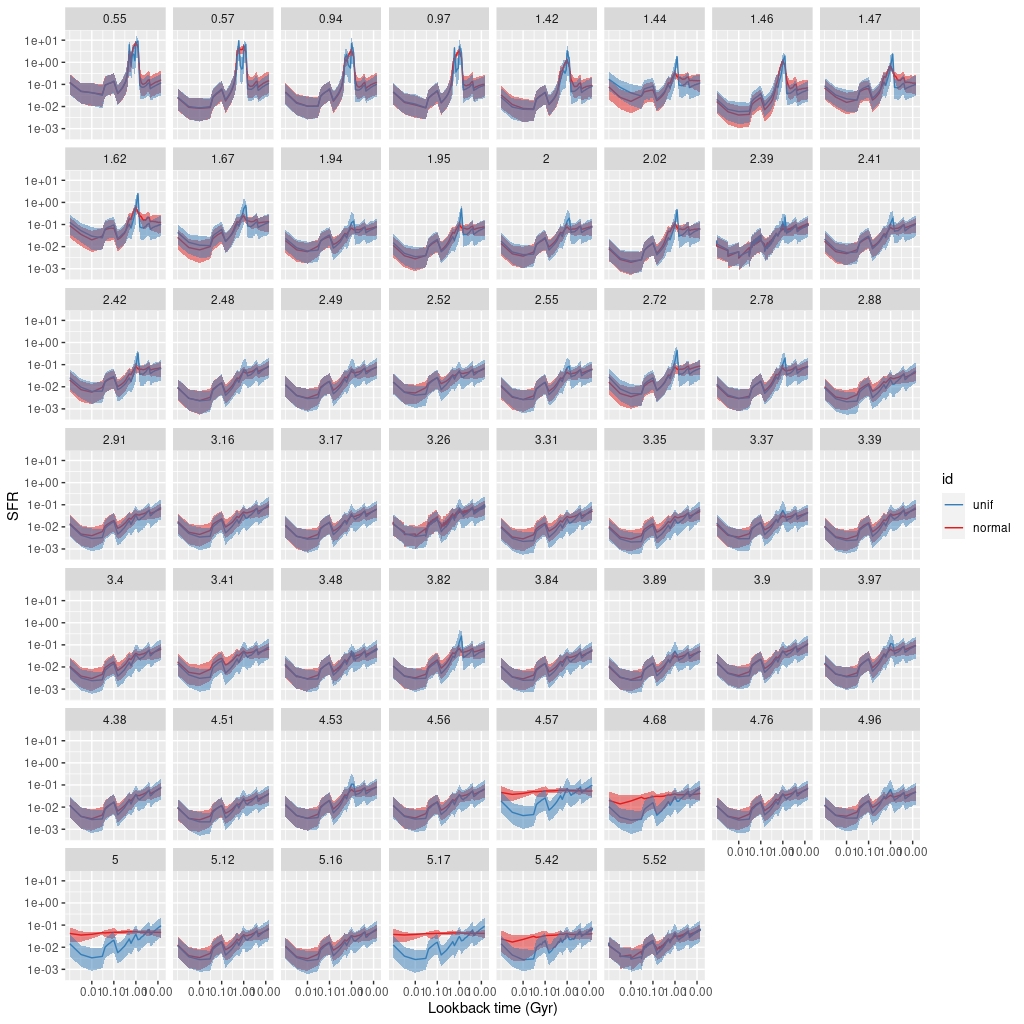After my not so insightful realization recounted last time that my attempt to modify the prior on star formation histories wasn’t actually doing anything I thought a little further about how to specify one. Gaussians are always popular choices for priors, so why not give them a try? For a first cut I added the following lines to the “transformed data” section of the Stan model:
vector[nt*nz] norm_sfr; norm_sfr = (dT .* norm_st)/sum(dT .* norm_st) ;
Then I added a scale parameter sd_sf to the parameters section, and finally in the model section:
sd_sf ~ normal(0., 1.);
b_st_s ~ normal(norm_sfr, sd_sf);
Even though the prior allows values of the stellar contributions that are infeasible given the simplex declaration this causes no technical problems: the models sample without complaint and parameters satisfy all constraints. Execution times are comparable to the original model formulation and convergence diagnostics are OK. But, the model runs had some unexpected features. I did a set of model runs for a single MaNGA galaxy from the post-starburst ancillary sample — mangaid 1-201936 (plateifu 10220-3703). Model star formation histories compared to the original model are shown below for the 58 binned spectra:

What’s striking here is that several of the spectra in the low S/N outskirts of the galaxy have nearly constant star formation rates with very little sample variation. In other words the models are basically returning the priors. The cause of this behavior isn’t quite clear. Relatively low signal to noise seems to be necessary, but not sufficient since similarly noisy spectra have essentially the same SFH’s as the original model formulation. It also isn’t due to convergence failure because much longer runs with more adaptation iterations show the same behavior. It is possible perhaps that the posteriors are significantly multimodal and Stan is preferentially falling into one of them. Notable also is that the fits to the data measured by log-likelihood are virtually identical even for the runs with the anomalous SFH’s. At the very least this tells us that uncertainties in quantities derived from the models are considerably larger than within model run variations — of course I have always believed this and said so a number of times.
After trying several variations on this theme that either had none at all or undesirable effects on sampling, and after some additional consideration I think that, given the model parametrization, the uniform on the simplex prior for stellar contributions is actually the one I want. That leaves the question of what, if anything, to do about the abrupt jumps in model star formation rates.
One possibility is simply to redefine the endpoints of the age bins to be, say, halfway between nominal SSP ages instead of at the model ages as is my current practice. In the case of the EMILES library this would mean for example that the 3.75, 4, 4.5 Gyr bins would have widths of 0.25, 0.375, 0.5 Gyr instead of the present 0.25, 0.25, 0.5. This involves no change to the actual model runs at all, so most quantities derived from the models are unchanged.
Another solution is to adopt a library with a more uniform age progression. One with approximately equal increments in log age seems preferred. As yet there have been no published updates to the MaStar based SSP libraries mentioned last time, so I’m waiting for them, while still considering generating my own.
I’m going to briefly return to BPASS based models. After that I’m not sure.
